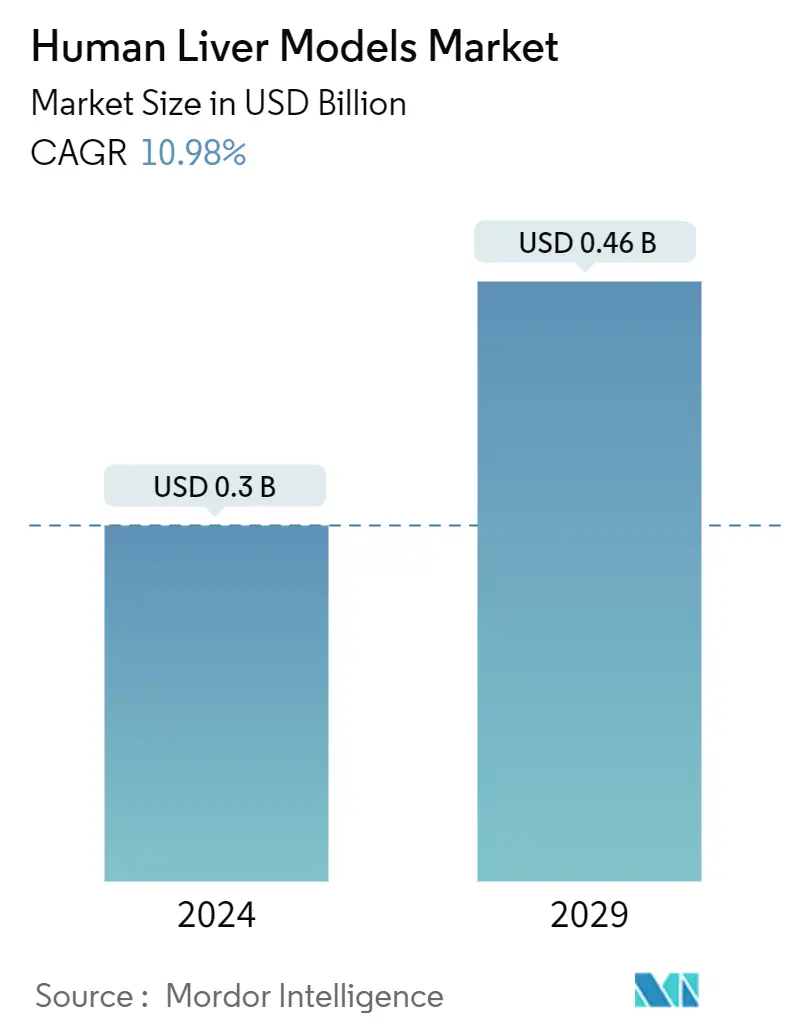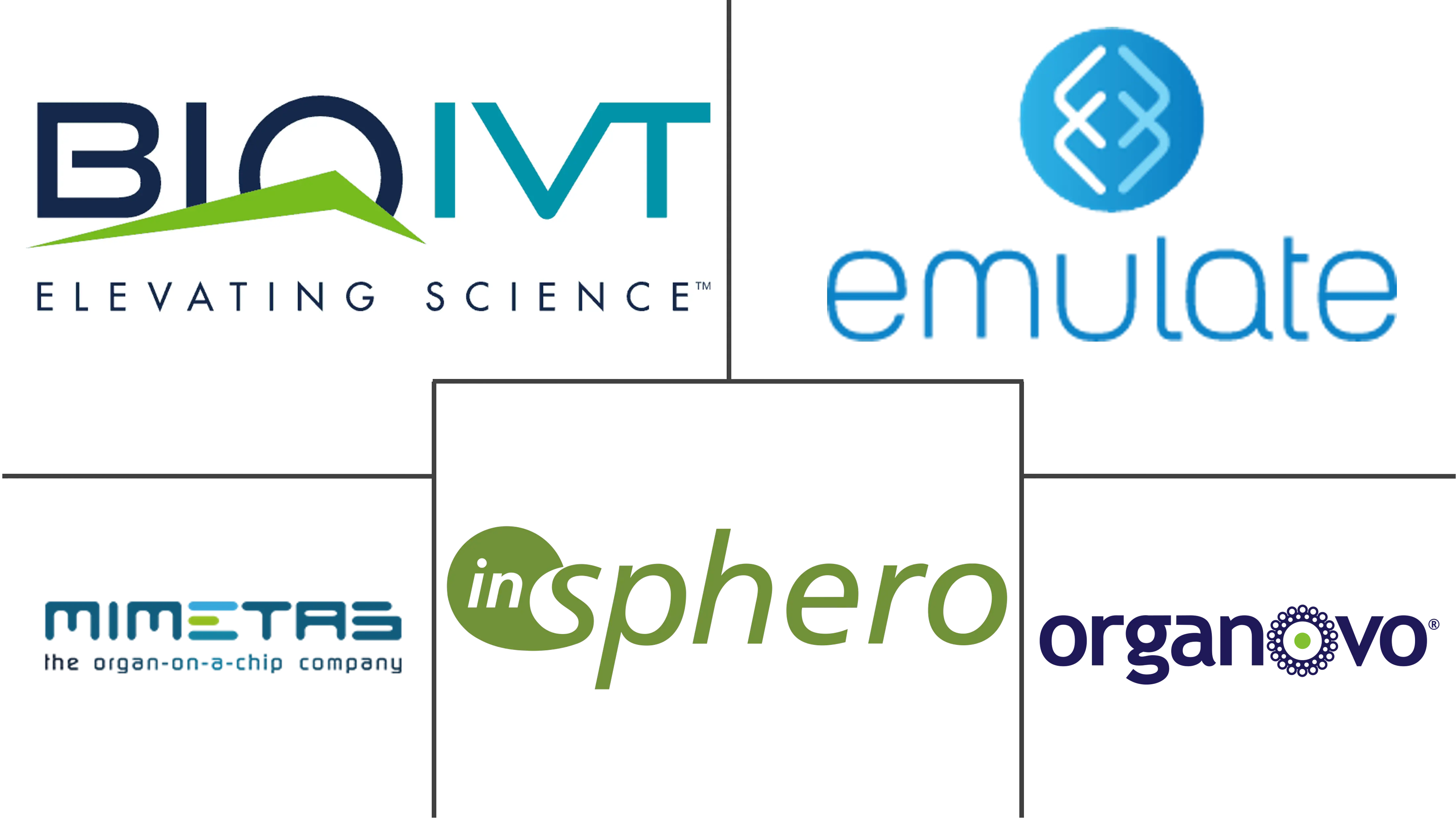Market Size of Human Liver Models Industry

| Study Period | 2019 - 2029 |
| Market Size (2024) | USD 0.3 Billion |
| Market Size (2029) | USD 0.46 Billion |
| CAGR (2024 - 2029) | 10.98 % |
| Fastest Growing Market | Asia Pacific |
| Largest Market | North America |
Major Players
*Disclaimer: Major Players sorted in no particular order |
Human Liver Models Market Analysis
The Human Liver Models Market size is estimated at USD 0.3 billion in 2024, and is expected to reach USD 0.46 billion by 2029, growing at a CAGR of 10.98% during the forecast period (2024-2029).
The COVID-19 pandemic had a significant impact on the market studied. As per the data from the CDC published in October 2021, the geriatric population included patients with serious underlying medical conditions, including people with liver disease, who were at a higher risk for severe illness from COVID-19. Patients with hepatocellular carcinoma (HCC), which occurs most often in people with chronic liver diseases, such as hepatitis B or hepatitis C, were at a higher risk for severe COVID-19 than those without hepatocellular carcinoma. However, during the pandemic, the focus of the healthcare industry was inclined toward COVID-19 management, which affected the market studied. Currently, the market has reached its pre-pandemic nature in terms of research and demand for human liver models and is expected to witness strong growth in the coming years.
The key factors responsible for the market growth include the increasing prevalence of liver diseases and advancements in organ printing technologies. In addition, the increasing focus on developing alternatives for animal-based models and accuracy in outcomes is projected to boost market growth. Moreover, the increasing prevalence of non-fatty acid liver disease and alcohol consumption that is leading to liver diseases is anticipated to fuel the market growth over the forecast period.
The change in the current lifestyle led to the exposure of a large population to certain risk factors that contribute to liver cancer. The risk factors include type-2 diabetes, hepatitis, metabolic disorders, excess body weight, alcohol consumption, and smoking. According to the GLOBOCAN data, globally, in 2020, there were around 905,677 (4.7%) new liver cancer cases and 830,180 (8.3%) deaths due to liver cancer. Moreover, the high demand for therapeutic drugs for liver cancer is expected to create wide opportunities for the market players for drug discovery with the help of liver models.
Hepatocellular carcinoma (HCC) and chronic liver disease are fatal illnesses with few curative alternatives. Therapeutic research is hampered by a shortage of experimental models that are clinically applicable and tractable. As per the data from Precision Bioscience published in September 2021, there is a significant unmet medical need for chemoprevention of liver disease progression toward cancer development due to the high prevalence of advanced liver fibrosis and cirrhosis, which are predicted to impact between 1% and 2% of the world's population. Therefore, with the rising prevalence of liver diseases, there is a growing demand for human liver models for study purposes, which is augmenting the market growth.
However, the high cost of liver models and issues with the incorporation of liver models into the existing workflow are expected to hamper the market growth over the forecast period.
Human Liver Models Industry Segmentation
As per the scope of this report, the liver is an important organ that performs vital body functions such as the synthesis of blood clotting factors, bile production, protein production, and detoxification. Human liver models are used to study the toxicity of the drug and enable an understanding of the effect of drugs and the progression of liver disease. The Human Liver Models Market is segmented by Product Type (2D Models, 3D Models, Liver-on-a-Chip, Other Product Types), Application (Education, Drug Discovery, Other Applications), and Geography (North America, Europe, Asia-Pacific, Middle East and Africa, and South America). The report also covers the estimated market sizes and trends for 17 countries across major regions globally. The report offers the value in USD for the above segments.
| By Product Type | |
| 2D Models | |
| 3D Models | |
| Liver-on-a-Chip | |
| Other Product Types |
| By Application | |
| Eduction | |
| Drug Discovery | |
| Other Applications |
| Geography | ||||||||
| ||||||||
| ||||||||
| ||||||||
| ||||||||
|
Human Liver Models Market Size Summary
The human liver models market is poised for significant growth, driven by the increasing prevalence of liver diseases and advancements in organ printing technologies. The market is recovering from the impacts of the COVID-19 pandemic, which had diverted attention towards pandemic management, but is now witnessing a resurgence in research and demand. The shift towards developing alternatives to animal-based models and the pursuit of more accurate outcomes are key factors propelling market expansion. Additionally, lifestyle changes contributing to liver disease risk factors, such as type-2 diabetes, hepatitis, and alcohol consumption, are expected to further fuel market growth. The demand for therapeutic drugs for liver cancer also presents substantial opportunities for market players in drug discovery.
Technological advancements, particularly in liver-on-a-chip systems, are anticipated to drive the market forward. These bioengineered systems offer a cost-effective alternative to traditional models, aligning with the growing demand for economical solutions in drug discovery and development. The market is characterized by moderate consolidation, with key players focusing on product innovation and regional expansion. North America is expected to dominate the market due to its robust R&D expenditure and the presence of major market players. The rising incidence of liver cancer and the increasing demand for liver transplants in the United States are significant contributors to market growth in the region.
Human Liver Models Market Size - Table of Contents
-
1. MARKET DYNAMICS
-
1.1 Market Overview
-
1.2 Market Drivers
-
1.2.1 Increasing Prevalence of Chronic Diseases and Geriatric Population
-
1.2.2 Increasing Demand For Technologically Advanced Stretchers
-
-
1.3 Market Restraints
-
1.3.1 High Cost of Specialized Stretchers
-
1.3.2 Growing Adoption of Home Healthcare
-
-
1.4 Porter's Five Forces Analysis
-
1.4.1 Bargaining Power of Buyers/Consumers
-
1.4.2 Bargaining Power of Suppliers
-
1.4.3 Threat of New Entrants
-
1.4.4 Threat of Substitute Products
-
1.4.5 Intensity of Competitive Rivalry
-
-
-
2. MARKET SEGMENTATION
-
2.1 By Product Type
-
2.1.1 2D Models
-
2.1.2 3D Models
-
2.1.3 Liver-on-a-Chip
-
2.1.4 Other Product Types
-
-
2.2 By Application
-
2.2.1 Eduction
-
2.2.2 Drug Discovery
-
2.2.3 Other Applications
-
-
2.3 Geography
-
2.3.1 North America
-
2.3.1.1 United States
-
2.3.1.2 Canada
-
2.3.1.3 Mexico
-
-
2.3.2 Europe
-
2.3.2.1 Germany
-
2.3.2.2 United Kingdom
-
2.3.2.3 France
-
2.3.2.4 Italy
-
2.3.2.5 Spain
-
2.3.2.6 Rest of Europe
-
-
2.3.3 Asia-Pacific
-
2.3.3.1 China
-
2.3.3.2 Japan
-
2.3.3.3 India
-
2.3.3.4 Australia
-
2.3.3.5 South Korea
-
2.3.3.6 Rest of Asia-Pacific
-
-
2.3.4 Middle-East and Africa
-
2.3.4.1 GCC
-
2.3.4.2 South Africa
-
2.3.4.3 Rest of Middle-East and Africa
-
-
2.3.5 South America
-
2.3.5.1 Brazil
-
2.3.5.2 Argentina
-
2.3.5.3 Rest of South America
-
-
-
Human Liver Models Market Size FAQs
How big is the Human Liver Models Market?
The Human Liver Models Market size is expected to reach USD 0.3 billion in 2024 and grow at a CAGR of 10.98% to reach USD 0.46 billion by 2029.
What is the current Human Liver Models Market size?
In 2024, the Human Liver Models Market size is expected to reach USD 0.3 billion.

